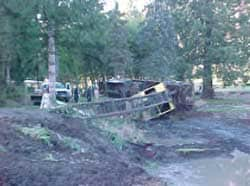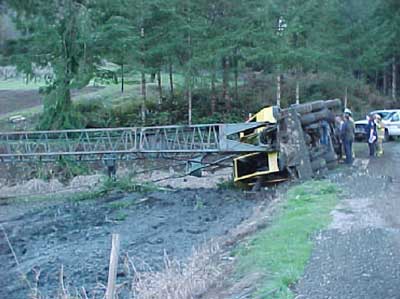Worker Is Thrown From Cab of Crane and Is Crushed
Oregon Case Report: 03-OR-039-01
Summary
On November 6, 2003 at approximately 1430 hrs., a carrier-mounted lattice boom crane toppled over killing the operator. The 66-year old victim had more than 30 years of experience operating heavy equipment in the logging industry.
The victim had been working for several days dredging fishponds at a commercial trout farm near his home. He had been helping the farm owner, his friend, with the dredging operation intermittently over several days and they were nearly finished when the incident occurred. The victim had just moved the crane onto a slip of land between two ponds to clear a channel between them. After he finished this work he dropped the bucket into to dry pond to dredge out some additional mud and debris that he was unable to reach from a previous position on the shoreline. As he began to bring in the bucket the crane began to fall onto its right side. The victim jumped from the operator’s cab and was crushed by the carriage mount of the crane. The owner believes that the victim would have survived if he had remained in the cab. The victim died before he could be extricated from under the toppled crane.
Recommendations:
- Know the proper use and limitations of the machinery you are operating. Operators of heavy equipment must have appropriate training and/or licenses before operating the equipment.
- Proper set-up is essential to safe crane operation. Always deploy outriggers before operating the crane. Understand the center of gravity of the load being lifted and avoid side or end pulls.
- Equipment should have appropriate and approved personal protection or restraint systems; older equipment lacking such systems should be retrofitted to current standards.
Back to Top
Investigation
This incident occurred at a privately operated rainbow trout farm. The farm is at the end of a paved road (12 miles off main road) and in a remote part of the county. The owner is a retired 87-year old gentleman who maintains the farm operation for personal enjoyment and a modest income in his retirement years.
The farm has several ponds that are used to contain rainbow trout in various stages of development. Fresh water enters the pond system from a stream that originates in the mountains behind the property. Silt and debris from the stream settle out into the first of the series of fishponds in the facility. Regular maintenance is required to keep the first pond from silting in and causing the other ponds to subsequently fill in with silt and debris killing the trout. The incident occurred while dredging this pond.
The property owner had purchased the crane a few months before the incident because he believed it would more economical to own a crane and keep it onsite rather than to rent one or hire a contractor. The victim was a close friend who often assisted the owner with maintenance and had experience operating heavy construction equipment. The property owner asked the victim to operate the crane and dredge the pond. Both agreed that the victim’s prior experience operating heavy logging equipment would be beneficial in learning to operate the crane. The victim appeared to the owner to have a good understanding of how to operate and control the equipment and the property owner left him alone to dredge out the pond. The property owner was operating a small tractor in the drained pond at the same time and was able to see the victim and crane at all times.
The victim maneuvered the crane onto a slip of land between two adjacent fishponds so that he could clean out some bypass canals. He had completed his bypass cleanout and had moved the crane back towards the shore of the pond when he stopped the crane. He dropped the bucket before getting back to shore, without resetting the outriggers, to dredge some mud and debris that was a little too far to reach from the position on shore. The victim had the boom of the crane angled about 30 degrees from the carriage and as the dragline bucket was being retrieved, the pull on the load of mud caused the crane to tip off balance. The crane fell over on its right side (see Photos 1 and 2). The property owner, who was out in the dry pond operating a small tractor moving gravel around on the pond’s bottom, recalls seeing the crane tip over “as if in slow motion”. The property owner reported saying that he saw the victim jump from the operator cab landing on the ground just inside the pond. The crane then continued tipping over and fell onto the victim. The soft earth cushioned and partially sheltered the victim from the full impact of the crane’s weight. He survived the initial crane falling on him only to succumb, under the equipment, a short time later. No other equipment was immediately available to lift the crane or extricate the victim and assistance to remove the victim from beneath the crane was delayed due to the remote location and distance. The county sheriff and the local medical examiner arrived on scene a short time after the incident. The operator was pronounced dead on the scene.

|
|
Photo 1. Boom crane on its side near fishpond.
|

|
|
Photo 2. Crane topples over, crushing worker, while dredging dry fish pond.
Note: outriggers were not deployed. |
Cause of Death
Blunt trauma to chest.
Back to Top
Recommendations/Discussion
Recommendation #1: Know the proper use and limitations of the machinery you are operating. Operators of heavy equipment must have appropriate training and/or licenses before operating the equipment.
Discussion:
The crane operator did not have any training on the specific equipment. Both he and the property owner relied upon the victims 30 years of experience using heavy equipment in logging industry to guide them in deciding to let the victim operate the crane.
Having an experienced crane operator explain the operation of the crane and how it would function in dredging operations may have prevented the victim from attempting to dredge without first deploying the outriggers. Operators should have an understanding of minimal requirements to ensure personal safety before operating unfamiliar equipment.
Recommendation #2: Equipment should have appropriate and approved personal protection or restraint systems; older equipment lacking such systems should be retrofitted to current standards.
Discussion:
The crane’s carriage fell across the victim while the cab remained relatively intact. Witnesses acknowledged that it is highly likely that the victim would have survived the incident if he had stayed in the operator’s cab. Personal restraint systems prevent the operator from exiting or being ejected from the safety of the cab enclosure. This older model of crane did not have a personal restraint system. Newer models do come equipped with restraint systems and older models can be retrofitted with them.
Recommendation #3: Proper set-up is essential to safe crane operation. Always deploy outriggers before operating the crane. Understand the center of gravity of the load being lifted and avoid side or end pulls.
Discussion:
The crane was equipped with outriggers. The victim had stopped to bring some silt material closer to shore so that he could then finish dredging the pond from the shore presumably with the outriggers deployed.
The crane operator over extended the operational envelope of the dredging system when he attempted to dredge at an approximate 30-degree angle to the centerline of the crane’s carriage without using the outriggers. The dredging bucket was being dragged back to the crane, when the crane became unbalanced and tipped over.
Back to Top
References
- http://www.camd.lsu.edu/msds/cranetraining.htmexternal icon (Link updated 9/25/2008)
- http://ehs.okstate.edu/links/cranes.htmexternal icon (Link updated 9/26/2008)
Oregon FACE Program
The Center for Research on Occupational and Environmental Toxicology at Oregon Health & Science University performs Fatality Assessment and Control Evaluation (FACE) investigations through a cooperative agreement with the National Institute for Occupational Safety and Health (NIOSH), Division of Safety Research (DSR). The goal of these evaluations is to prevent fatal work injuries in the future by studying the working environment, the worker, the task the worker was performing, the tools the worker was using, the energy exchange resulting in fatal injury, and the role of management in controlling how these factors interact.
To contact Oregon State FACE program personnel regarding State-based FACE reports, please use information listed on the Contact Sheet on the NIOSH FACE web site. Please contact In-house FACE program personnel regarding In-house FACE reports and to gain assistance when State-FACE program personnel cannot be reached.
Oregon FACE reports are for information, research, or occupational injury control only. Safety and health practices may have changed since the investigation was conducted and the report was completed. Persons needing regulatory compliance information should consult the appropriate regulatory agency.
Back to Top

